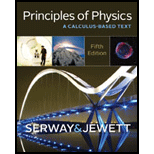
Concept explainers
(a)
The number of carbon atoms in the given sample.
(a)
Answer to Problem 24P
The number of carbon atoms in the given sample is
Explanation of Solution
Write the equation to find the number of carbon atoms.
Here,
Conclusion:
Substitute
Therefore, the number of carbon atoms in the given sample is
(b)
The number of carbon atoms in the given sample.
(b)
Answer to Problem 24P
The number of carbon-14 atoms in the given sample is
Explanation of Solution
Write the equation to find the number of carbon-14 atoms.
Here,
Conclusion:
Substitute
Therefore, the number of carbon-14 atoms in the given sample is
(c)
The decay constant for carbon-14 in inverse seconds.
(c)
Answer to Problem 24P
The decay constant for carbon-14 in inverse seconds is
Explanation of Solution
Write the equation to find the half-life time of carbon-14.
Here,
Conclusion:
Substitute
Therefore, the decay constant for carbon-14 in inverse seconds is
(d)
The number of initial number of decays in a week immediately after the death of species.
(d)
Answer to Problem 24P
The number of initial number of decays in a week immediately after the death of species is
Explanation of Solution
Write the equation to find the decay rate.
Here,
Write the equation to find
Here,
Rewrite the equation for
To find the
Conclusion:
Substitute
Therefore, the number of initial number of decays in a week immediately after the death of species is
(e)
The new number of decays in a week in the current sample.
(e)
Answer to Problem 24P
The new number of decays in a week in the current sample is
Explanation of Solution
Write the equation to find the new number of decays in a week in the current sample.
Here,
Conclusion:
Substitute
Therefore, the new number of decays in a week in the current sample is
(f)
Lifetime of specimen in years using the results from part (c) and (d).
(f)
Answer to Problem 24P
Lifetime of specimen is
Explanation of Solution
Write the equation to find the fraction of decay.
Apply logarithm on both sides.
Rewrite the above equation in terms of
Conclusion:
Substitute
Therefore, the lifetime of specimen is
Want to see more full solutions like this?
Chapter 30 Solutions
Principles of Physics
- What is the dose in mSv for: (a) a 0.1 Gy xray? (b) 2.5 mGy of neutron exposure to the eye? (c) 1.5 mGy of exposure?arrow_forwardData from the appendices and the periodic table may be needed for these problems. Show that the activity of the 14C in 1.00 g of 12C found in living tissue is 0.250 Bq.arrow_forwardA beam of 168MeV nitrogen nuclei is used for cancer therapy. If this beam is directed onto a 0.200kg tumor and gives it a 2.00Sv dose, how many nitrogen nuclei were stopped? (Use an RBE of 20 for heavy ions.)arrow_forward
 Physics for Scientists and Engineers with Modern ...PhysicsISBN:9781337553292Author:Raymond A. Serway, John W. JewettPublisher:Cengage Learning
Physics for Scientists and Engineers with Modern ...PhysicsISBN:9781337553292Author:Raymond A. Serway, John W. JewettPublisher:Cengage Learning Principles of Physics: A Calculus-Based TextPhysicsISBN:9781133104261Author:Raymond A. Serway, John W. JewettPublisher:Cengage Learning
Principles of Physics: A Calculus-Based TextPhysicsISBN:9781133104261Author:Raymond A. Serway, John W. JewettPublisher:Cengage Learning College PhysicsPhysicsISBN:9781305952300Author:Raymond A. Serway, Chris VuillePublisher:Cengage Learning
College PhysicsPhysicsISBN:9781305952300Author:Raymond A. Serway, Chris VuillePublisher:Cengage Learning College PhysicsPhysicsISBN:9781285737027Author:Raymond A. Serway, Chris VuillePublisher:Cengage Learning
College PhysicsPhysicsISBN:9781285737027Author:Raymond A. Serway, Chris VuillePublisher:Cengage Learning Modern PhysicsPhysicsISBN:9781111794378Author:Raymond A. Serway, Clement J. Moses, Curt A. MoyerPublisher:Cengage Learning
Modern PhysicsPhysicsISBN:9781111794378Author:Raymond A. Serway, Clement J. Moses, Curt A. MoyerPublisher:Cengage Learning College PhysicsPhysicsISBN:9781938168000Author:Paul Peter Urone, Roger HinrichsPublisher:OpenStax College
College PhysicsPhysicsISBN:9781938168000Author:Paul Peter Urone, Roger HinrichsPublisher:OpenStax College





